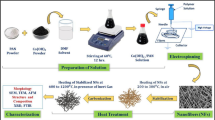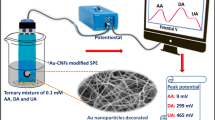Abstract
Carbon nanofiber (CNF) was prepared by electrospinning using polypropylene and nickel was coated on the CNF by electroless plating. Then, graphene (Gr) was synthesized on the surface of nickel by chemical vapor deposition. After etching nickel, the Gr/CNF was obtained eventually and then used as a working electrode for the determination of levodopa in the presence of uric acid by cyclic voltammetry and differential pulse voltammetry. The morphology and structure were investigated by scanning electron microscopy and Raman spectroscopy, respectively. The results indicate that the electrode exhibits a high sensitivity of 0.26 μA·μM−1 and a low measured limit of detection of 1 μM for levodopa in the range of 1–60 μM. The electrode shows excellent selectivity, reproducibility, and stability. It was also applied to determine levodopa in the spiked human urine samples.










Similar content being viewed by others
References
Jindal K, Tomar M, Gupta V (2014) Inducing electrocatalytic functionality in ZnO thin film by N doping to realize a third generation uric acid biosensor. Biosens Bioelectron 55(9):57–65. https://doi.org/10.1016/j.bios.2013.11.015
Mazloum-Ardakani M, Taleat Z, Khoshroo A, Beitollahi H, Dehghani H (2012) Electrocatalytic oxidation and voltammetric determination of levodopa in the presence of carbidopa at the surface of a nanostructure based electrochemical sensor. Biosens Bioelectron 35(1):75–81. https://doi.org/10.1016/j.bios.2012.02.014
Yue HY, Wang B, Huang S, Gao X, Lin XY, Yao LH, Guan EH, Zhang HJ, Song SS (2017) Determination of levodopa in the presence of uric acid using a ZnO nanoflower-modified indium tin oxide glass electrode. Ionics 23(12):3479–3486. https://doi.org/10.1007/s11581-017-2153-3
Hu GZ, Zhang DP, Wu WL, Yang ZS (2008) Selective determination of dopamine in the presence of high concentration of ascorbic acid using nano-Au self-assembly glassy carbon electrode. Colloids Surf B 62(2):199–205. https://doi.org/10.1016/j.colsurfb.2007.10.001
Yuan Q, Liu Y, Ye C, Sun H, Dai D, Wei Q, Lai G, Wu T, Yu A, Fu L, Chee K, Lin C (2018) Highly stable and regenerative graphene-diamond hybrid electrochemical biosensor for fouling target dopamine detection. Biosens Bioelectron 111(111):117–123. https://doi.org/10.1016/j.bios.2018.04.006
Fu L, Wang A, Lai G, Su W, Malherbe F, Yu J, Lin C, Yu A (2018) Defects regulating of graphene ink for electrochemical determination of ascorbic acid, dopamine and uric acid. Talanta 180(180):248–253. https://doi.org/10.1016/j.talanta.2017.12.058
Long Q, Fang A, Wen Y, Li H, Zhang Y, Yao S (2016) Rapid and highly-sensitive uric acid sensing based on enzymatic catalysis-induced upconversion inner filter effect. Biosens Bioelectron 86(86):109–114. https://doi.org/10.1016/j.bios.2016.06.017
Du J, Yue R, Ren F, Yao Z, Jiang F, Yang P, Du Y (2014) Novel graphene flowers modified carbon fibers for simultaneous determination of ascorbic acid, dopamine and uric acid. Biosens Bioelectron 53(4):220–224. https://doi.org/10.1016/j.bios.2013.09.064
Yang YJ, Li W (2014) CTAB functionalized graphene oxide/multiwalled carbon nanotube composite modified electrode for the simultaneous determination of ascorbic acid, dopamine, uric acid and nitrite. Biosens Bioelectron 56(56):300–306. https://doi.org/10.1016/j.bios.2014.01.037
Yue HY, Zhang H, Huang S, Lin XY, Gao X, Chang J, Yao LH, Guo EJ (2017) Synthesis of ZnO nanowire arrays/3D graphene foam and application for determination of levodopa in the presence of uric acid. Biosens Bioelectron 89(Pt 1):592–597. https://doi.org/10.1016/j.bios.2016.01.078
Zhao D, Yu G, Tian K, Xu C (2016) A highly sensitive and stable electrochemical sensor for simultaneous detection towards ascorbic acid, dopamine, and uric acid based on the hierarchical nanoporous PtTi alloy. Biosens Bioelectron 82(82):119–126. https://doi.org/10.1016/j.bios.2016.03.074
Arvand M, Ghodsi N (2013) A voltammetric sensor based on graphene-modified electrode for the determination of trace amounts of l-dopa in mouse brain extract and pharmaceuticals. J Solid State Electrochem 17(3):775–784. https://doi.org/10.1007/s10008-012-1929-7
Luo YC, Do JS, Liu CC (2006) An amperometric uric acid biosensor based on modified Ir-C electrode. Biosens Bioelectron 22(4):482–488. https://doi.org/10.1016/j.bios.2006.07.013
Arvand M, Ghodsi N (2014) Electrospun TiO2 nanofiber/graphite oxide modified electrode for electrochemical detection of L-DOPA in human cerebrospinal fluid. Sensors Actuators B 204(204):393–401. https://doi.org/10.1016/j.snb.2014.07.110
Rezaei B, Shams-Ghahfarokhi L, Havakeshian E, Ensafi AA (2016) An electrochemical biosensor based on nanoporous stainless steel modified by gold and palladium nanoparticles for simultaneous determination of levodopa and uric acid. Talanta 158(158):42–50. https://doi.org/10.1016/j.talanta.2016.04.061
Jong KD, Geus J (2000) Carbon nanofibers: catalytic synthesis and applications. Catal Rev 42(4):481–510. https://doi.org/10.1081/CR-100101954
Yang S, Taha-Tijerina J, Serrato-Diaz V, Hernandez K, Lozano K (2007) Dynamic mechanical and thermal analysis of aligned vapor grown carbon nanofiber reinforced polyethylene. Compos Part B 38(2):228–235. https://doi.org/10.1016/j.compositesb.2006.04.003
Tolosa A, Krüner B, Jäckel N, Aslan M, Vakifahmetoglu C, Presser V (2016) Electrospinning and electrospraying of silicon oxycarbide-derived nanoporous carbon for supercapacitor electrodes. J Power Sources 313(313):178–188. https://doi.org/10.1016/j.jpowsour.2016.02.077
Kim C, Cho YJ, Yun WY, Ngoc BTN, Yang KS, Chang DR, Lee JW, Kojima M, Kim YA, Endo M (2007) Fabrications and structural characterization of ultra-fine carbon fibres by electrospinning of polymer blends. Solid State Commun 142(1–2):20–23. https://doi.org/10.1016/j.ssc.2007.01.030
Liu C, Liu J, Wang J, Li J, Luo R, Shen J, Sun X, Han W, Wang L (2018) Electrospun mulberry-like hierarchical carbon fiber web for high-performance supercapacitors. J Colloid Interface Sci 512(512):713–721. https://doi.org/10.1016/j.jcis.2017.10.093
Chinnappan A, Lee JKY, Jayathilaka WADM, Ramakrishna S (2018) Fabrication of MWCNT/Cu nanofibers via electrospinning method and analysis of their electrical conductivity by four-probe method. Int J Hydrog Energy 43(2):721–729. https://doi.org/10.1016/j.ijhydene.2017.11.028
Ning H, Xie H, Zhao Q, Liu J, Tian W, Wang Y, Wu M (2017) Electrospinning ZnO/carbon nanofiber as binder-free and self-supported anode for Li-ion batteries. J Alloys Compd 722(722):716–720. https://doi.org/10.1016/j.jallcom.2017.06.099
Xu J, Zhang L, Xu G, Sun Z, Zhang C, Ma X, Qi C, Zhang L, Jia D (2018) Facile synthesis of NiS anchored carbon nanofibers for high-performance supercapacitors. Appl Surf Sci 434(434):112–119. https://doi.org/10.1016/j.apsusc.2017.09.233
Wei Y, Zhang L, Gong C, Liu S, Zhang M, Shi Y, Zhang J (2018) Fabrication of TiN/carbon nanofibers by electrospinning and their electromagnetic wave absorption properties. J Alloys Compd 735(735):1488–1493. https://doi.org/10.1016/j.jallcom.2017.11.295
Cinti S, Arduini F (2017) Graphene-based screen-printed electrochemical (bio)sensors and their applications: efforts and criticisms. Biosens Bioelectron 89(Pt 1):107–122. https://doi.org/10.1016/j.bios.2016.07.005
Wang MH, Ji BW, Gu XW, Tian HC, Kang XY, Yang B, Wang XL, Chen X, Li CY, Liu JQ (2018) Direct electrodeposition of graphene enhanced conductive polymer on microelectrode for biosensing application. Biosens Bioelectron 99(99):99–107. https://doi.org/10.1016/j.bios.2017.07.030
Fu L, Lai G, Jia B, Yu A (2014) Preparation and electrocatalytic properties of polydopamine functionalized reduced graphene oxide-silver nanocomposites. Electrocatalysis 6(1):72–76. https://doi.org/10.1007/s12678-014-0219-9
Tian F, Lyu J, Shi J, Yang M (2017) Graphene and graphene-like two-denominational materials based fluorescence resonance energy transfer (FRET) assays for biological applications. Biosens Bioelectron 89(Pt 1):123–135. https://doi.org/10.1016/j.bios.2016.06.046
Afsahi S, Lerner MB, Goldstein JM, Lee J, Tang X, Bagarozzi DA, Pan D, Locascio L, Walker A, Barron F, Goldsmith BR (2018) Novel graphene-based biosensor for early detection of Zika virus infection. Biosens Bioelectron 100(100):85–88. https://doi.org/10.1016/j.bios.2017.08.051
Zhang H, Zhang H, Aldalbahi A, Zuo X, Fan C, Mi X (2017) Fluorescent biosensors enabled by graphene and graphene oxide. Biosens Bioelectron 89(Pt 1):96–106. https://doi.org/10.1016/j.bios.2016.07.030
Shi L, Chen K, Du R, Bachmatiuk A, Rümmeli MH, Xie K, Huang Y, Zhang Y, Liu Z (2016) Scalable seashell-based chemical vapor deposition growth of three-dimensional graphene foams for oil–water separation. J Am Chem Soc 138(20):6360–6363. https://doi.org/10.1021/jacs.6b02262
Li Q, Newberg JT, Walter EC, And JCH, Penner RM (2004) Polycrystalline molybdenum disulfide (2H−MoS2) nano- and microribbons by electrochemical/chemical synthesis. Nano Lett 4(2):277–281. https://doi.org/10.1021/nl035011f
Dryhurst G (1972) Electrochemical oxidation of uric acid and xanthine at the pyrolytic graphite electrode. J Electrochem Soc 119(12):1659–1664. https://doi.org/10.1149/1.2404066
Yoon SM, Choi WM, Baik H, Shin HJ, Song I, Kwon MS, Bae JJ, Kim H, Lee YH, Choi JY (2012) Synthesis of multilayer graphene balls by carbon segregation from nickel nanoparticles. ACS Nano 6(8):6803–6811. https://doi.org/10.1021/nn301546z
Hadi M, Rouhollahi A (2012) Simultaneous electrochemical sensing of ascorbic acid, dopamine and uric acid at anodized nanocrystalline graphite-like pyrolytic carbon film electrode. Anal Chim Acta 721(7):55–60. https://doi.org/10.1016/j.aca.2012.01.051
Eksin E, Zor E, Erdem A, Bingol H (2017) Electrochemical monitoring of biointeraction by graphene-based material modified pencil graphite electrode. Biosensors & Bioelectronics 92:207–14. https://doi.org/10.1016/j.bios.2017.02.016
Funding
This work is supported by the Natural Science Foundation of Heilongjiang Province (LC2015020), Technology Foundation for Selected Overseas Chinese Scholar, Ministry of Personnel of China (2015192), the Innovative Talent Fund of Harbin city (2016RAQXJ185), and Science Funds for the Young Innovative Talents of HUST (201604).
Author information
Authors and Affiliations
Corresponding author
Additional information
Highlights
1. Nickel is coated on the carbon nanofiber (CNF) by electroless nickel plating.
2. Graphene (Gr) was grown on the surface of nickel by chemical vapor deposition.
3. The Gr/CNF shows a high sensitivity of 0.26 μA·μM−1 for determination of levodopa.
4. The Gr/CNF also shows a low measured limit of detection, excellent selectivity and stability.
Electronic supplementary material
ESM 1
(DOC 281 kb)
Rights and permissions
About this article
Cite this article
Wang, W.Q., Yue, H.Y., Yu, Z.M. et al. Synthesis of graphene/carbon nanofiber for electrochemical determination of levodopa in the presence of uric acid. Ionics 25, 2835–2843 (2019). https://doi.org/10.1007/s11581-018-2801-2
Received:
Revised:
Accepted:
Published:
Issue Date:
DOI: https://doi.org/10.1007/s11581-018-2801-2




